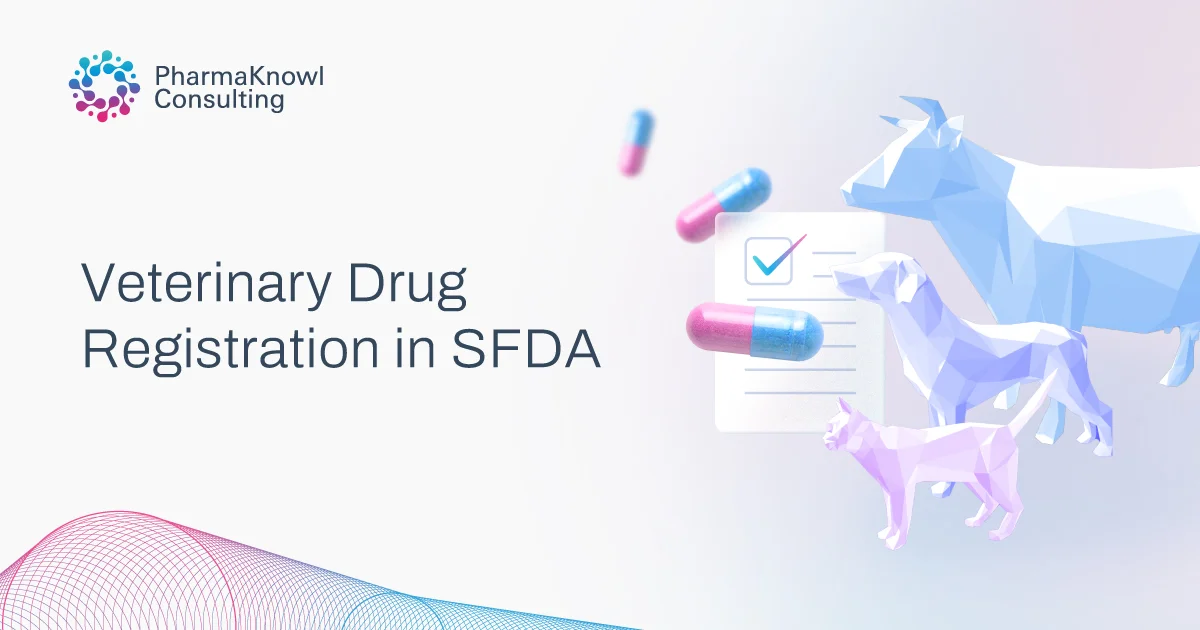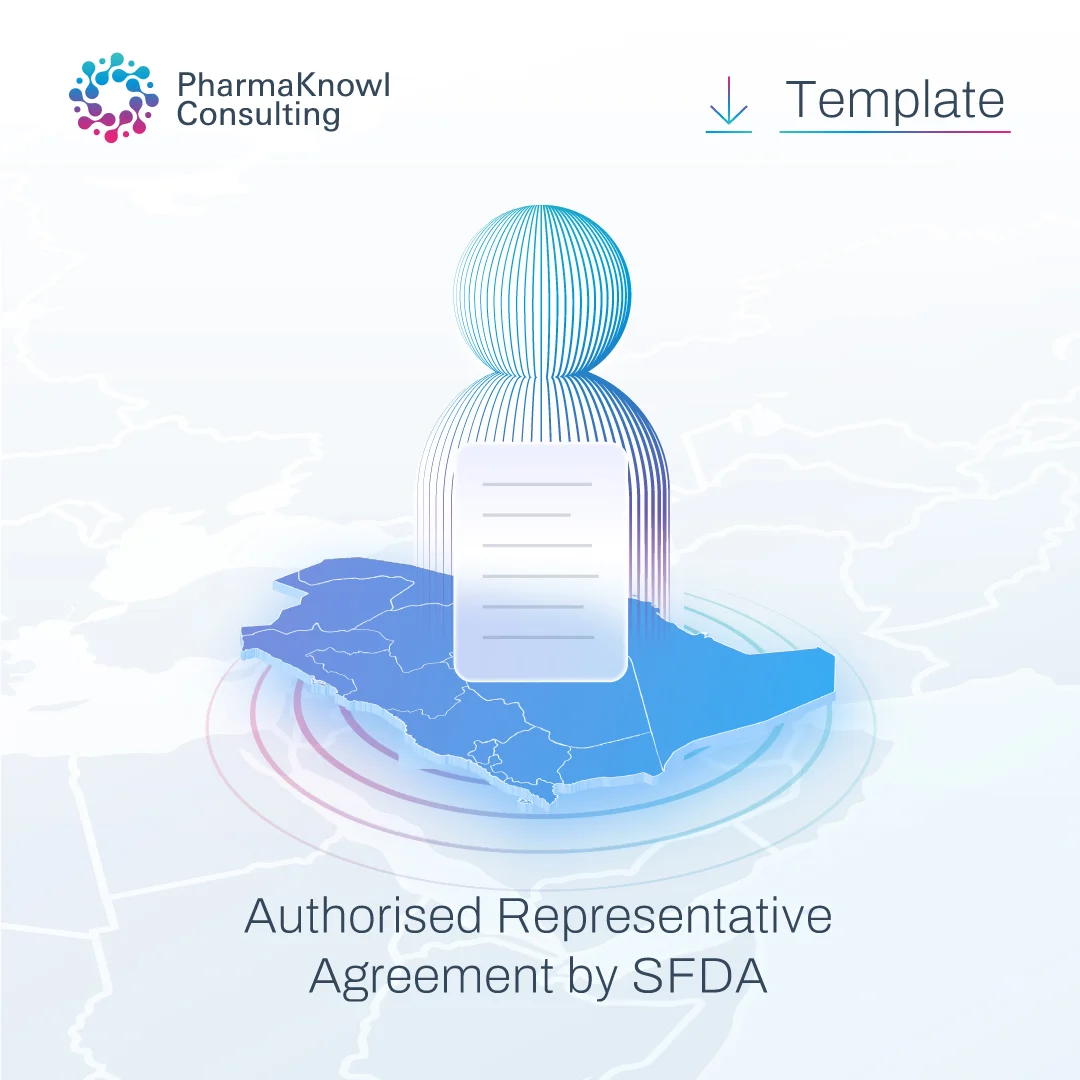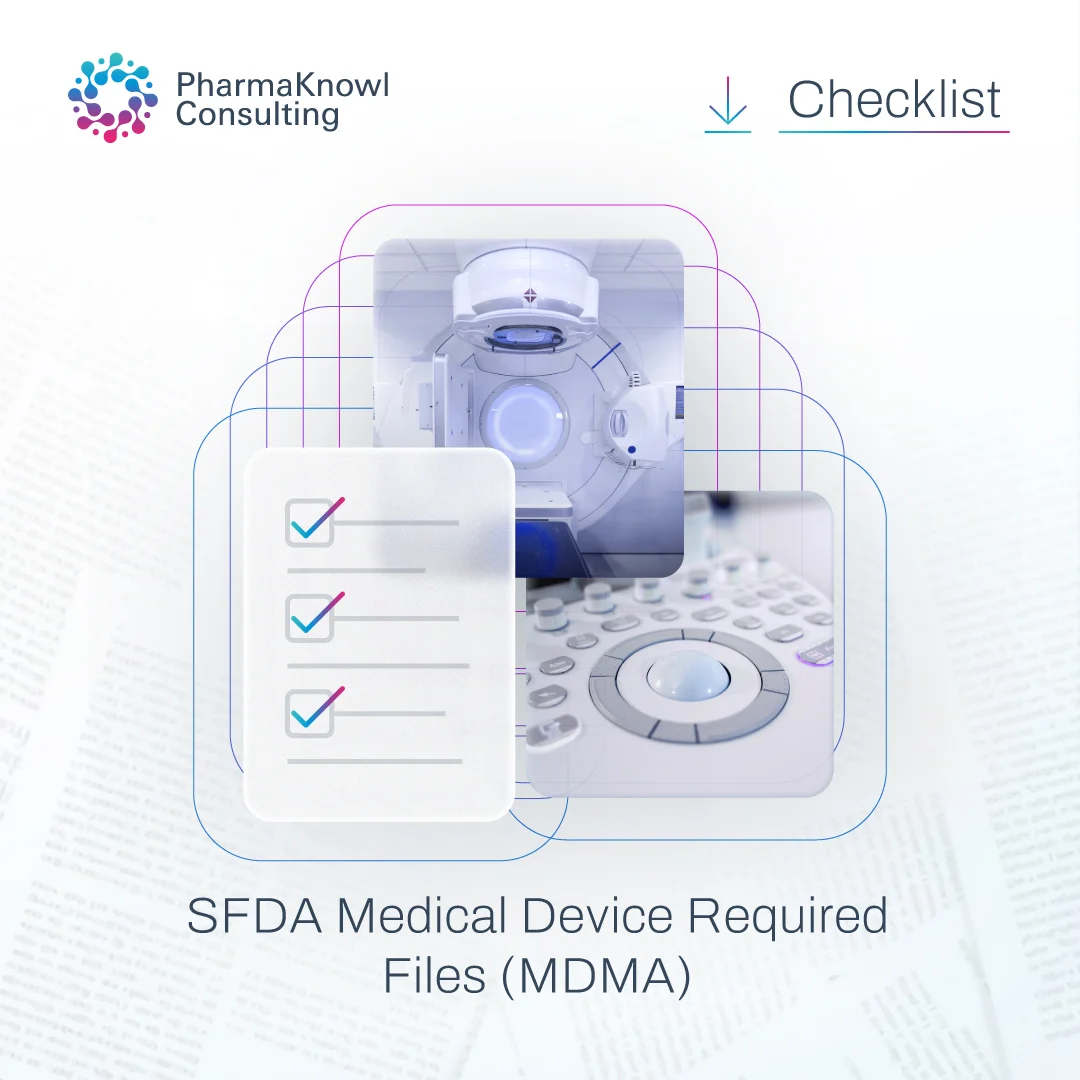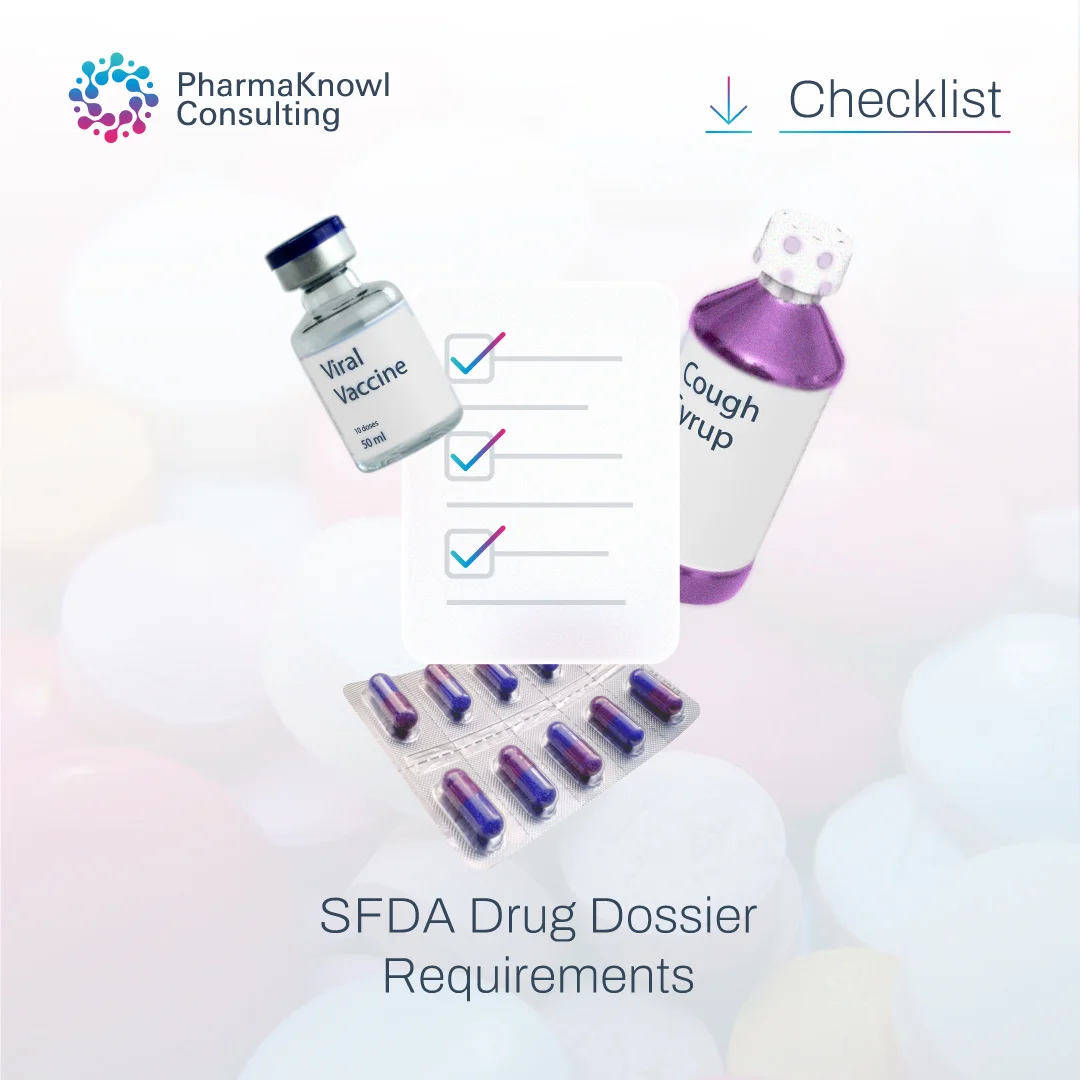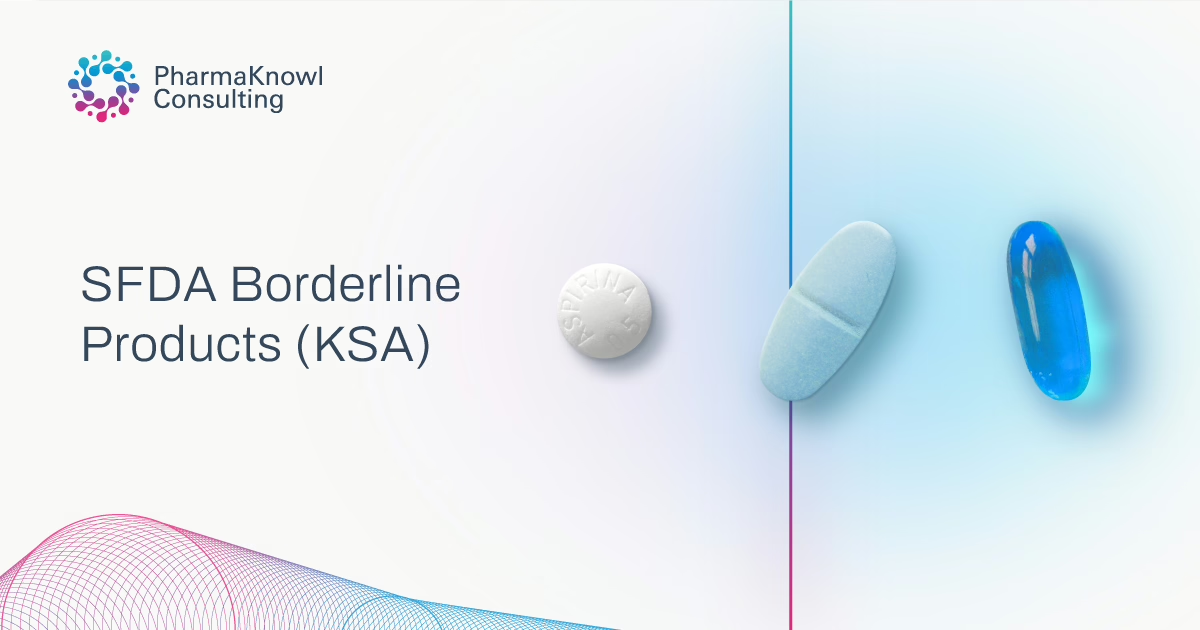Regulatory compliance is critical to ensuring product safety and efficacy in the rapidly evolving field of veterinary drug products. This article provides a comprehensive overview of the Saudi Food and Drug Authority’s (SFDA) requirements for registering veterinary medicine.
Table of contents
Veterinary Drug Dossier Requirements
The following documents are the SFDA requirements for veterinary drug registration. Applicants must compile them in a vNeeS ctd dossier:
Part 1: Summary of the Veterinary Dossier
- 1a Administrative Information
- 1a1 Cover Letter
- 1a2 Application Form
- 1a3 Pharmacovigilance
- 1a31 Pharmacovigilance System
- 1a32 Risk Management Plan
- 1a4 Certificates and Documents
- 1a41 GMP Certificate
- 1a42 CPP
- 1a43 Certificate of Analysis – Drug Substances & Finished Product
- 1a44 Certificate of Analysis – Excipients
- 1a45 Certificate of Suitability
- 1a46 Patent Information
- 1a47 Letter of Access to DMF
- 1a5 Pricing
- 1a51 Price List
- 1a52 Other Documents Related
- 1a6 Responses to Questions
- 1a7 Additional Data
- 1b SPC and Product Literature
- 1b1 Summary of Product Characteristics (SPC)
- 1b2 Package Leaflet (PL)
- 1b21 Arabic Leaflet
- 1b22 English Leaflet
- 1b3 Labeling
- 1b4 Artwork (Mock-ups)
- 1b5 Samples
- 1c Critical Summaries
- 1c1 Quality
- 1c2 Safety and Residues
- 1c3 Efficacy
Part 2 Quality Documentation
- 2a Qualitative and Quantitative Particulars
- 2a1 Qualitative Particulars
- 2a2 Usual Terminology
- 2a3 Quantitative Particulars
- 2a4 Development of pharmaceutics
- 2b Description of the Manufacturing Method
- 2b1 Manufacturer and Batch Formula
- 2b2 Description of the Manufacturing Process and Process Controls
- 2b3 Facility, Equipment, Controls of Critical Steps and Intermediates
- 2b4 Process Validation and/or Evaluation
- 2c Control of Starting Materials
- 2c1 Active Substance(s)
- 2c2 Excipient(s)
- 2c3 Container / Closure System
- 2c4 Substances of Biological Origin
- 2d Control Tests at Intermediate Process Stages
- 2e Tests on the Finished Product
- 2e1 Specifications of the Finished Product
- 2e2 General Characteristics of the Finished Product
- 2e3 Identification and Assay of Active Substance(s)
- 2e4 Identification and Assay of Excipient Components
- 2e5 Safety Tests
- 2f Stability Tests
- 2f1 Active Substances(s)
- 2f2 Finished Product
- 2g Other Information
Part 3 Safety and Residues Tests
- 3a Safety Tests
- 3a1 Precise Identification of the Product and its Active Substance(s)
- 3a2 Pharmacology
- 3a3 Toxicology
- 3a4 Other Requirements
- 3a5 URA (User Safety)
- 3a6 ERA (Environmental Risk Assessment)
- 3b Residue tests
- 3b1 Introduction
- 3b2 Identification of Product
- 3b3 Metabolism and Residue Kinetics
- 3b4 Residue Analytical Method
Part 4 Preclinical and Clinical Trials
- 4a Preclinical Requirements
- 4a1 Pharmacology
- 4a2 Resistance
- 4a3 Target Animal Tolerance
- 4b Clinical Requirements
- 4b1 Clinical Trials
New Veterinary Drug
All parts 1, 2, 3, and 4 are required.
Generic Veterinary Drug
- Data Content: The submission must only include the information outlined in Parts 1 and 2.
- Impurity Profile: A detailed summary of impurities found in both the active substance batches and the finished product, including any degradation products from storage, with an evaluation of their impact.
- Bioequivalence Studies: A review of the bioequivalence study results or an explanation of whether such studies were not conducted according to established guidelines.
- Additional Comparisons (if applicable): When different salts, esters, or derivatives of an approved active substance are used, data must show that these variations do not alter the pharmacokinetic or pharmacodynamic properties or toxicity, thereby preserving the safety and efficacy profile.
Additional Data for Specific Administration Routes:
- Residue Depletion: For products administered intramuscularly, subcutaneously, or transdermally, provide evidence (e.g., residue depletion studies) showing whether residue levels at the administration site are equivalent or different.
- Local Tolerance: Provide evidence, supported by tolerance studies, demonstrating that the product is tolerated well at the target animal’s administration site.
Biosimilar Veterinary Drug
- Expanded Data Requirements: For similar biological veterinary drugs, the dossier must extend beyond Parts 1 and 2 (which include bioequivalence and bioavailability data) and include additional safety and efficacy data.
- Case-by-Case Assessment: The type and amount of extra data—such as toxicological, additional safety, and clinical studies—will be determined individually according to relevant scientific guidelines.
- Customised Study Requirements: Because biological products vary widely, the SFDA will specify the necessary studies (as outlined in Parts 3 and 4) based on each product’s unique characteristics.
- Multiple Indications: If the reference product is approved for more than one indication, the similar product must justify or, if needed, separately demonstrate its safety and efficacy for each indication claimed.
Timeline and Fees
For the most updated information, refer to the following posts:
Who Can Apply?
Local licensed companies can submit to the SFDA, but foreign companies have specific possible submission routes. Learn more about those routes in our article: SFDA Registration.
Conclusion
The SFDA’s comprehensive requirements for veterinary medicinal products underscore the importance of rigorous quality, safety, and efficacy evaluations. By adhering to these requirements, stakeholders can ensure the successful registration of their products and safeguard animal and public health.
Registration Service
You may explore outsourcing the registration project to our full-time regulatory professionals, experts in registering veterinary pharmaceuticals, vaccines, and other biological veterinary products. Contact us to schedule a discovery meeting.
Read More
About the Author
Regulatory Affairs Specialist at PharmaKnowl, supporting SFDA compliance for the pharmaceutical and biotech sectors.
Resources
Services
Events
